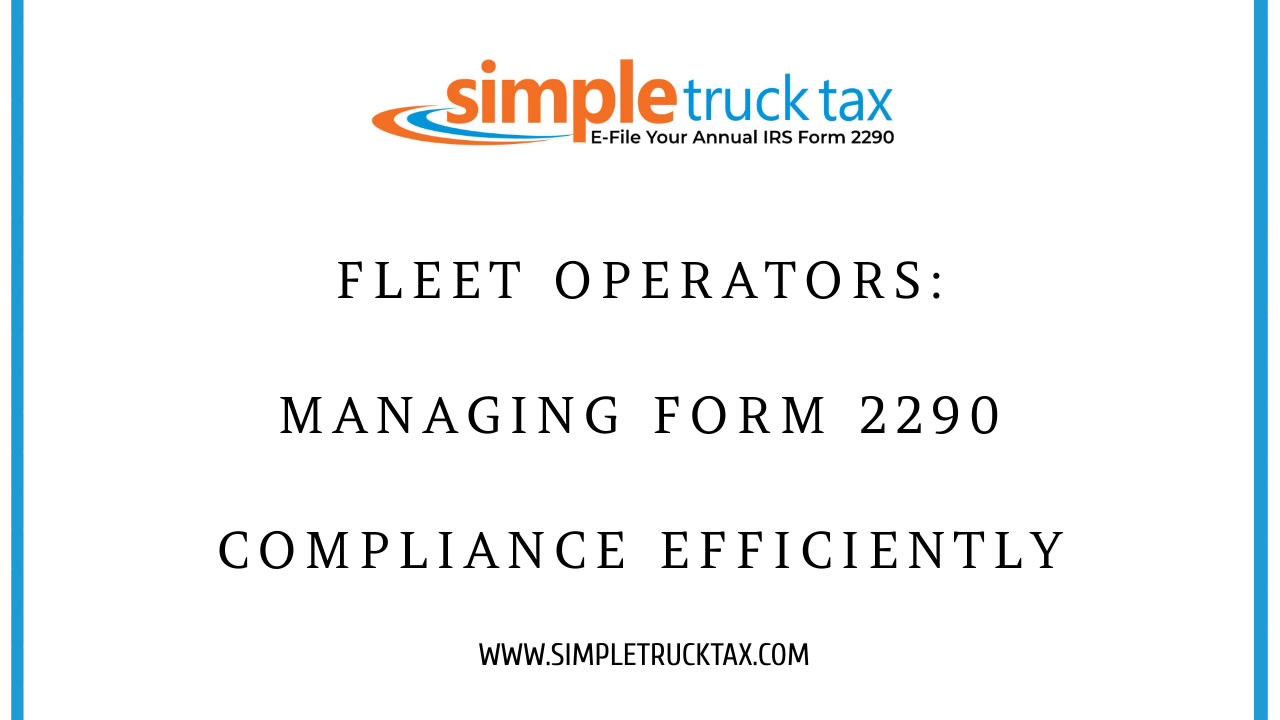
Fleet Operators: Managing Form 2290 Compliance Efficiently
Overseeing a big fleet of vehicles means dealing with a large number of obligations, among which is ensuring compliance with the tax rules. It is required by the United States for a fleet to submit Form 2290 Heavy Highway Vehicle Use Tax Return. The efficient handling of Form 2290 Heavy Use Tax Return will help to save time, avoid penalties, and gain the confidence of smooth operation. The parts that follow reveal a number of ways for the fleet operators to implement it.
The Understanding stage of Form 2290 includes
The form is imposed by IRS for all the vehicles which have a taxable gross weight of 55,000 pounds or more operating on public highways. The revenue from the tax is leveraged to maintain the highway and its infrastructure. Furthermore, fleet operators shall have to file the Form and pay the relevant tax for each qualifying vehicle annually.
The Significance of Fulfilling the Requirement
Failure to comply with Form 2290 requirement may cause excessive fines and interest. Moreover, Schedule 1 from Form 2290 is the evidence that the tax is paid and is required during a vehicle registration. Timely obedience is a critical component for unhampered fleet operations and legal consequences prevention.
The Steps to Efficient Compliance
- Organize Vehicle Documentation One of the most significant steps in making the process of Form 2290 compliance more efficient is arranging vehicle documentation. An updated record of the taxable gross weight, mileage, and the purpose of use of particular vehicles is the fuel for compiling the form as closely as possible to the reality.
- Use digital tools Leverage digital tools and software designed for fleet management and tax compliance. These tools can automate the process of calculating the tax due, filling out Form 2290, and submitting it electronically to the IRS. In this way, automation helps minimize errors and reduces time loss.:
- Set Up Reminders Set up reminders for specific dates directly related to the Form 2290 like the due date for the payment. Though the annual deadline is on August 31st for the vehicles that have been used during the previous fiscal year, the more recent vehicles must be reported by the end of the month that comes after the month of first use. Reminders assist in the timely execution of the assigned tasks so that late fees and penalties are avoided.
Filing Form 2290 Electronically
The IRS suggests electronic filing (e-filing) of Form 2290, especially for a fleet of 25 or more vehicles. Electronic filing helps accomplish a more rapid process in obtaining the approval of receipt of the obligatory forms. Below is a step-by-step guidance for e-filing:
- Choose an IRS-Authorized e-File Provider: Choose a provider that offers good services and support.
- Register and Create an Account: In order to e-file, you'll be required to set up an account with the e-file service provider.
- Enter Vehicle Information: Input the details of all the vehicles you have including VIN, weight of the vehicle, the month of first use.
- Calculation of Tax: You should use the available tools of the e-file service provider for tax computation.
- Submission of the Form and Payment: File your Form 2290 electronically and make the payment through e-payment options like electronic funds withdrawal, EFTPS, or credit/debit card.
- Receive Schedule 1: Once the document is handled by the IRS, you will be given back a Schedule 1 appendix and carry official pay evidence.
Modification and Correction Administration
If any changes emerge in the park of a buyer of a new vehicle or changes in the old equipment because they have sold, the customer has to remit an amendment. Speed is vital when addressing any divergences arising. Fill on time the necessary many Form 2290 amendments in order to ensure correct business transactions.
Seeking Professional Help
In the cases of fleet operators being lost in the intricacies or being too busy to make use of the online system, professional services from tax consultants or accountants would be highly advantageous. The services consist of filling in the correct and timely information, tax-saving guidelines, and communications with the IRS.
For fleet operators, managing Form 2290 pattern is obligatory to ensure that their truck operation is seamless and does not become a limitation while still being compliant. Also, with each method like having the necessary documentation, using digital tools, setting schedules, and relying on outside experts, it can ease the filing out process. A switch to online processes and timely correction of submitted info will make everything even more smooth, so the fleet will always be compliant and operational throughout the year.
Note: For more information, visit IRS website